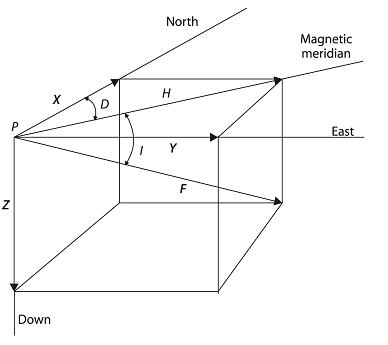|
|
Archaeomagnetism
Archaeomagnetism
investigates the history of the Earth's Magnetic Field (EMF), in terms
of the variations in direction and intensity it has experienced in the
past, using archaeological materials that have undergone
high-temperature heating processes (>300 - 400ºC). More
specifically, the materials of interest are fired clays (bricks, tiles,
adobes, ceramics) and sediments burnt in situ by the presence of
hearths, baths, cremation tombs and other combustion structures. The
principle of archaeomagnetism is based on the one hand on the
peculiarities of EMF and on the other hand on the magnetic properties
of some iron minerals commonly found in the above-mentioned materials.
Starting with EMF,
the aspects of interest from an archaeomagnetic perspective are the
following: First, from a physical point of view, 90% of the EMF
behaviour can be modelled by assuming a dipole field and geocentric
model. In other words, to a first approximation, the EMF at the Earth's
surface can be assumed to be the result of a magnetic dipole passing
through the centre of the Earth, currently tilted by 11.5° with
respect to the rotational axis of the planet. The difference between
the observed EMF orientation and intensity values at the Earth's
surface, and the theoretical values obtained by applying a dipole
model, is therefore quantified as 10%, which represents the non-dipole
field component. Due to factors partly residing outside the Earth
(external factors) and partly in the dynamics of the Earth's core
(internal factors) both dipolar and non-dipolar components experience
variations in time of different type and periodicity. It is considered
that the external factors produce variations of a period of less than
10 years in the orientation and intensity of the EMF at the Earth's
surface, while those due to internal factors generate variations of
greater periodicity, between 10 and 3000 years, and are called Secular
Variation (SV).
It should be noted
that the variations of the EMF due to internal causes are distributed
in a non-homogeneous way on the Earth's surface and are usually
considered uniform in regions with surfaces smaller than 10^6 Km^2
(Tarling, 1983), that is, approximately twice the size of Peninsular
Spain. At the Earth's surface the CMT is described by a vector of
intensity F and orientation defined by two angles corresponding to the
magnetic Declination (D) and the magnetic Inclination (l). The first is
the angle formed by the horizontal component (H) of the magnetic vector
(F) with the geographic North and varies between 0º and 360º.
The second is the angle formed by the vector F with the horizontal
plane, ranging from 0º to 90º for locations in the Northern
Hemisphere (fig. 1).

Figure 1. EMF components.
While short-period changes of F, D and I can be detected in magnetic
observatories by means of measuring devices, we will see below that
those of long periodicity have been recorded in a multitude of rocks
and in different archaeological materials.
The key to this phenomenon lies in some iron oxides contained in very
small quantities (<3%) in rocks and sediments of different lithology
and origin, but especially abundant in volcanic rocks and in clayey
materials that have been subjected to intense heating processes. The
most common oxides are magnetite, maghemite, haematite and goethite,
sometimes with partial substitution of iron by other cations such as
titanium, aluminium, silica. From a physical point of view, these
minerals are defined as "ferromagnetic", which implies that: (1) they
have a magnetic moment of their own, responding in a manner analogous
to a compass needle to the presence of an external magnetic field, and
(2) that under certain conditions their response to the external field
can be "locked" and permanently "imprinted" on them.
Although there are different mechanisms capable of determining the
acquisition of magnetisation by these oxides, the mechanism of interest
in archaeomagnetism is the one that acts by heating the materials with
ferromagnetic content and, therefore, here we will refer exclusively to
this one. At room temperature, the EMF, due to its low intensity, has
negligible effects on ferromagnetic minerals, but at temperatures of
the order of 700ºC, any "ferromagnetic" mineral passes to a state
called "super-paramagnetic" in which its sensitivity to the action of
an external field becomes much greater. Under these conditions, with an
intensity of only 60 microT, the EMF manages to magnetise the minerals,
i.e. to orient the magnetic moments of their atoms in the direction of
magnetic North. When the material is cooled, once a certain blocking
temperature (Tb) is reached, the magnetisation remains "blocked" and
remains stable despite subsequent variations in orientation and
intensity that the EMF may have.
The magnetisation acquired by this mechanism is defined as
"thermo-remanent magnetisation" (TRM) and can be destroyed if the
material is reheated a second time and its Tb is reached again. The
effect of the temperature increase is therefore to destroy the order
imparted to the atomic magnetic moments by the external field. On the
other hand, each time the material cools down, it becomes magnetised
again according to the new properties of the external field.
Thus, rocks originated from magmatic liquids by fractional
crystallisation processes retain a magnetisation that reflects the
characteristics of the EMF present at the time of their formation;
ceramic materials and bricks retain a remanence that refers to the time
when they were manufactured; a material that has undergone multiple
heating, for example the bricks of a kiln used for cooking tableware,
carries a remanence related to the EMF present during the last heating
process undergone.
It should now be clear that rocks and archaeological materials
constitute a true record of the EMF and that SV can be obtained if
materials are available in which the age of heating has been determined
by independent methods. The reference curve describing the orientation
and intensity of the EMF over historical and prehistoric times in a
given region is called the Paleosecular Variation Curve (PSVC), and can
be determined by archaeological/magnetic palaeomagnetic studies of
archaeological structures/rocks of different ages and homogeneously
distributed in the region under consideration. Studies that concern the
orientation of the EMF alone in the past are called archaeodirectional
(or palaeodirectional if the chronological scale is longer than 3000
years) while those that investigate the intensity of the EMF or are
based on it are called archaeointensity (or palaeointensity) studies.
Without insisting on the importance of knowing the history of the EMF,
it is worth mentioning that the observation of the magnetic properties
of rocks has been essential to understand significant aspects of the
dynamics of our planet and to elaborate, for example, such important
theories as Plate Tectonics and Deep Ocean Expansion. In order to
formulate the former, it has been necessary to observe differences in
the orientation of magnetisation in coeval rocks, while the latter is
based on the phenomena of magnetic polarity reversal observed in
volcanic rocks located next to oceanic trenches.
Turning now to the archaeological field, in those regions or countries
where a PSVC is already available, geomagnetism provides archaeological
research with a dating tool since the age of heating of a structure or
archaeological material can be determined by comparing the directional
(or intensity) values of the retained magnetisation with those of a
standard curve.
The Palaeomagnetism group has made important advances in this branch of
study in collaboration with other European centres, funded by the EU
(Archaeomagnetic Applications for the Rescue of the Cultural Heritage,
2003-2006), the MEC (Study of the secular variation of the Terrestrial
Magnetic Field in Europe during the last 10,000 years from
palaeomagnetic data) and the Community of Madrid. In 2006,
Gómez-Paccard et al. presented the First Catalogue of Archaeomagnetic Data and the First Secular Variation Curve for Iberia for the last 2800 years. In addition, Pavón-Carrasco et al. (2011) developed a novel dating tool that can be found on this page for download
bbased on geomagnetic field models developed from archaeomagnetic data.
More information on the models can be found on the page Modelling the Geomagnetic Field in the Past.
Although there is still a need to study new archaeomagnetic structures
to refine the accuracy of the PSVC and to increase the data density for
some historical epochs currently under-represented, the achievements
made now allow the use of the archaeomagnetic dating technique also in
the Iberian Peninsula.
A small selection of the most outstanding work carried out by the Paleomagnetism group in recent years:
Osete, M. L., Molina-Cardín, A., Campuzano, S. A., Aguilella-Arzo, G., Barrachina-Ibañez, A., Falomir-Granell, F., Oliver Foix, A., Gómez-Paccard,
M., Martín-Hernández, F., Palencia-Ortas, A.,
Pavón-Carrasco, F. J., Rivero-Montero, M. (2020). Two
archaeomagnetic intensity maxima and rapid directional variation rates
during the first Iron Age observed at Iberian coordinates. Implications
on the evolution of the Levantine Iron Age Anomaly. Earth and Planetary
Science Letters, 533, 116047. DOI: 10.1016/j.epsl.2019.116047
Gómez-Paccard, M., Rivero, M., Chauvin, A., García-Rubert, D., Palencia-Ortas, A.
(2019) Revisiting the chronology of the Eartly Iron Age in the
nort-eastern Iberian Peninsula. Archaeological and Anthropological
Sciences. DOI: 10.1007/s12520-019-00812-9
A.
Molina-Cardín, S. A. Campuzano, M. L. Osete, M. Rivero-Montero,
F. J. Pavón-Carrasco, A. Palencia-Ortas, F.
Martín-Hernández, M. Gómez-Paccard, A.
Chauvin, S. Guerrero-Suárez, J. C. Pérez-Fuentes, G.
McIntosh, G. Catanzariti, J.C. Sastre Blanco, J. Larrazabal, V. M.
Fernández Martínez, J. R. Álvarez Sanchís ,
J. Rodríguez-Hernández, I. Martín Viso and D.
Garcia i Rubert (2018). Updated Iberian Archeomagnetic Catalogue: New
Full Vector Paleosecular Variation Curve for the Last Three Millennia.
Geochemistry, Geophysics, Geosystems, 19, 3637 - 3656. DOI: 10.1029/2018GC007781
Gomez-Paccard, M., Beamud,
E., McIntosh, G., Larrasoaña, J.C., 2013. New
archaeomagnetic data recovered from the study of three Roman kilns from
north-east Spain: a contribution to the Iberian Palaeosecular variation
curve, Archaeometry, 55, 1. DOI: 10.1111/j.1475-4754.2010.00675.x
|
|



